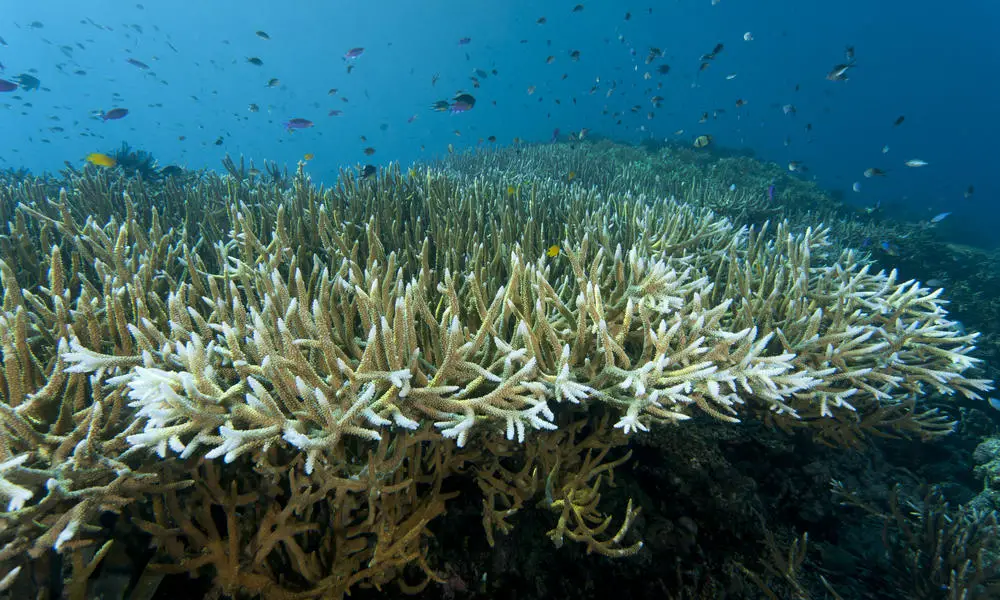Coral Bleaching: What Is Coral Bleaching? How Do We Stop It?
Tags: opinion

Coral bleaching is the whitening of the coral’s natural and vibrant colors. But the whole concept has much more to be spoken about than just that. Corals have their vibrancy of colors because of the microscopic algae we call zooxanthellae. These algae live inside the coral with a beneficial relationship that is mutual. Each of them helps the other survive.
As the environment of the ocean changes, the coral removes the algae as it stresses too much. This happens when the temperature gets too humid. Now, the coral does not actually bleach. But without the algae within, it eventually loses its color and becomes more faded. Hence, it looks like it’s bleached. And if the temperature remains high, the algae does not return to its place. This leads to the death of the coral.
This entire process is called coral bleaching.
READ: AUSTRALIAN WETLAND RESTORED BY TRANSFORMING 1,000-ACRE BLUEGUM PLANTATION
How Is Coral Bleaching Triggered?
There are many reasons that lead to coral bleaching. Some of them are very low tides, too much direct sunlight, or even pollution. But all of them are tied together with climate change. Climate change is the leading cause of the corals getting bleached.
Even heavy rainfall can result in coral bleaching. When fresh water is discharged into the ocean, the salinity reduces. Due to the reduced salinity, the corals are affected, and their natural habitat bleaches their texture.
Climate change means a change in the temperature. Our planet has been warming up for several years now. And with the rapid pace, it has become a difficult thing to tackle. And if the planet warms up, it means the oceans are also rising in temperature. Even if there is 2 degrees Fahrenheit rise in the water’s temperature, it results in the casting out of algae. And that means coral bleaching.
Does The Bleaching Matter?
The reef ecosystem is entirely affected by coral bleaching. It is the reason the corals die. When corals die, the reefs almost never come back. When corals are very low on survival, it faces problems with reproduction. Wildlife, as well as human beings, depend on the deteriorating reefs.
If businesses worldwide still lead an aggressive fossil fuel path, then by 2034, all of the corals on the planet will be bleached. Coral bleaching also is not just another isolated phenomenon. According to reports, over 75% of tropical reefs around the world had excessive heat-stress. All of them were on the brink of bleaching. About 30% of those very coral reefs, the nightmare came true, and they died.
Several coral scientists have also reported that the bleaching is also subjective to the geographical area. The levels of bleaching vary accordingly. Unlike several reports in the literature, some of them are harshly affected by thermal stresses, but there are still some that are not affected. The researches are done without the fact that there are several types of coral reefs in different regions.
Coral Bleaching’s Impact On Wildlife
Coral reefs provide support to biodiverse ecosystems around the planet. Marine life heavily depends on coral reefs when it comes to survival. Some of those include several species of starfish, jellyfish, crabs, sea turtles, fish, shrimp, sea birds, and many more.
The area of the reef also acts like shelter to many of these. It also serves as a spawning ground and helps to hide from many predatory animals in the blue. The area also supports several organisms that lie at the ocean food chain’s base. Many species are on the brink of extinction. And if the coral reefs collapse, these species may also fall prey to complete extinction.
Hence, the ecosystem helps to ensure a vibrant and healthy wildlife population.
Coral Bleaching’s Impact On Humans

Image Credit: Acropora
Coral bleaching can have an unseeable impact on human life. Coral reefs can influence livelihoods, safety, security, as well as food. The entire ecosystem is a natural barrier to storms and waves, absorbing most of the impact. They help keep the coastal communities out of much danger.
If there is no reef, the human-made structure will fall. And such seawalls have environmental and economic ramifications. They are also not compelling enough. Overfishing is also aided by the coral reefs by providing space for the fishes to hide. It deprives some fishes by eradicating links in the food chain. It takes away the dwelling space.
Several people who, in turn, depend on fishes for food or protein, in general, will also fall in trouble. The main problem here is the tourism of reefs. Reef tourism helps generate billions of dollars every year. Hence, it helps in thousands of employment. And finally, coral bleaching also leads to a devoid of many incredible species, killing them all.
READ: WHEN THEY HAD NO VISITORS, AUSTRALIAN SCUBA COMPANIES PLANTED CORAL ON THE GREAT BARRIER REEF
Our Role To Avoid Coral Bleaching
We are not entirely doomed. Yet. But if we want to avoid this, we have to start working towards it now. To save the future generations. There are simplest and smallest actions that can support the reduction of coral bleaching. These actions include fertilizer runoff or reduction of stormwater, or even avoiding pesticides and herbicides.
But in order to solve the problem wholly, we’ll have to address the root of it, i.e., climate change. This means there is a need for immediate, comprehensive actions to lower emissions globally. It is something several environmental organizations are working towards tirelessly.
There is a global emergency in working towards renewable energy consumption for cities, consumers, and businesses as well. We are all working to eradicate deforestation. We are also helping governments approach smart-climate policies. But there is a role for everyone. Together, we can eliminate, or at least slow down the rapid growth of coral bleaching.
And we need to do it before time runs out.
Image Featured WWF

Leave Comment: